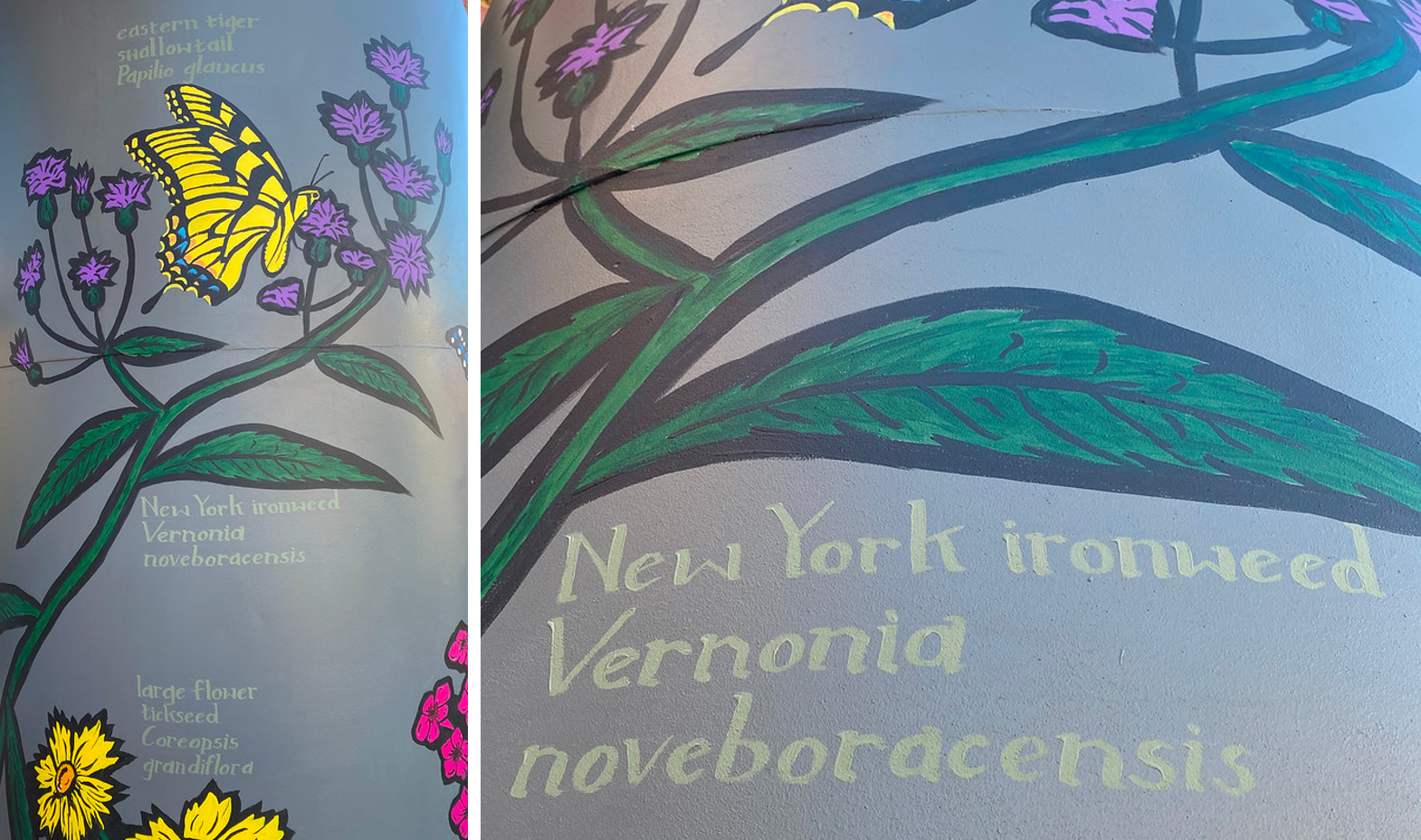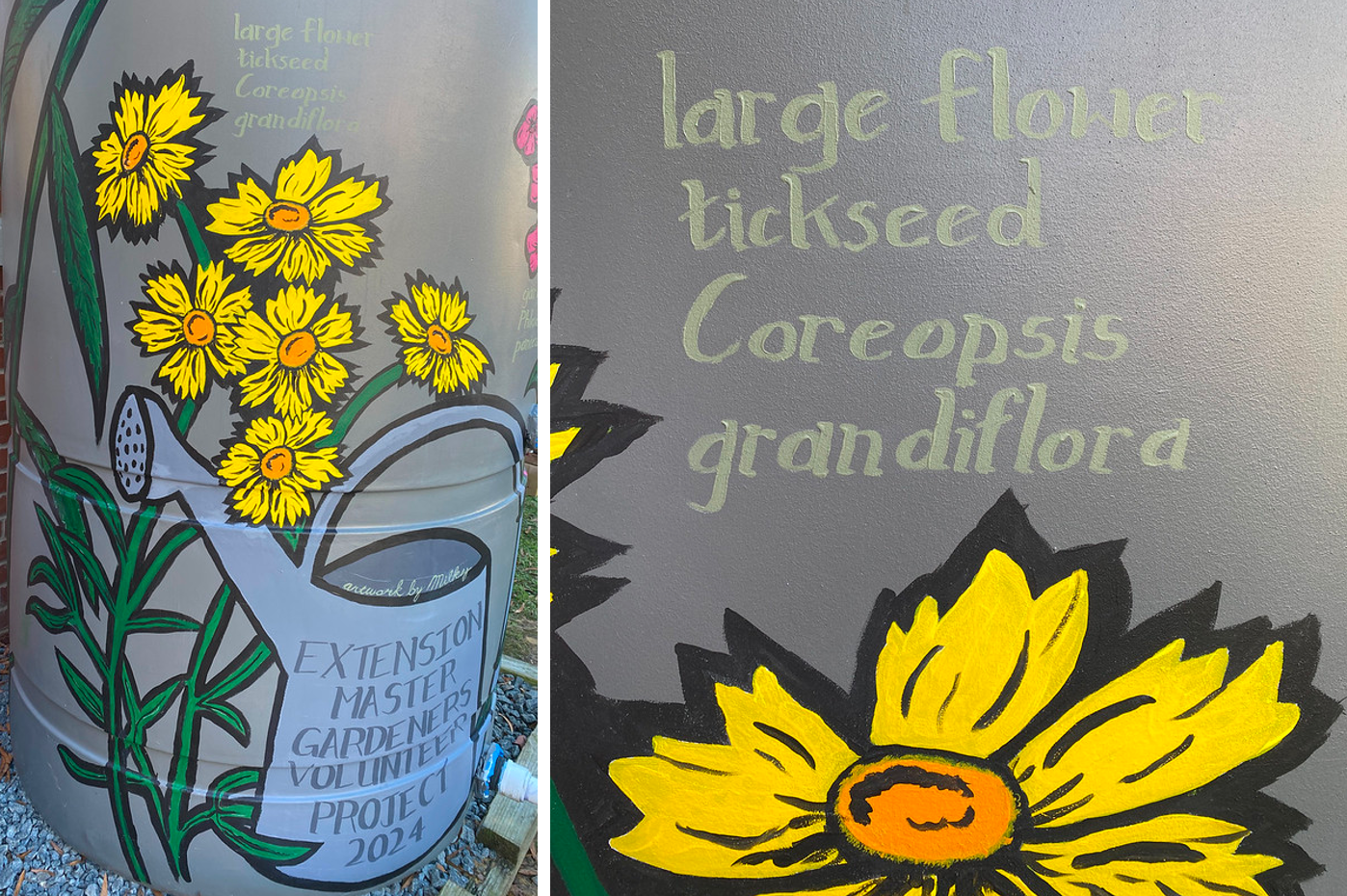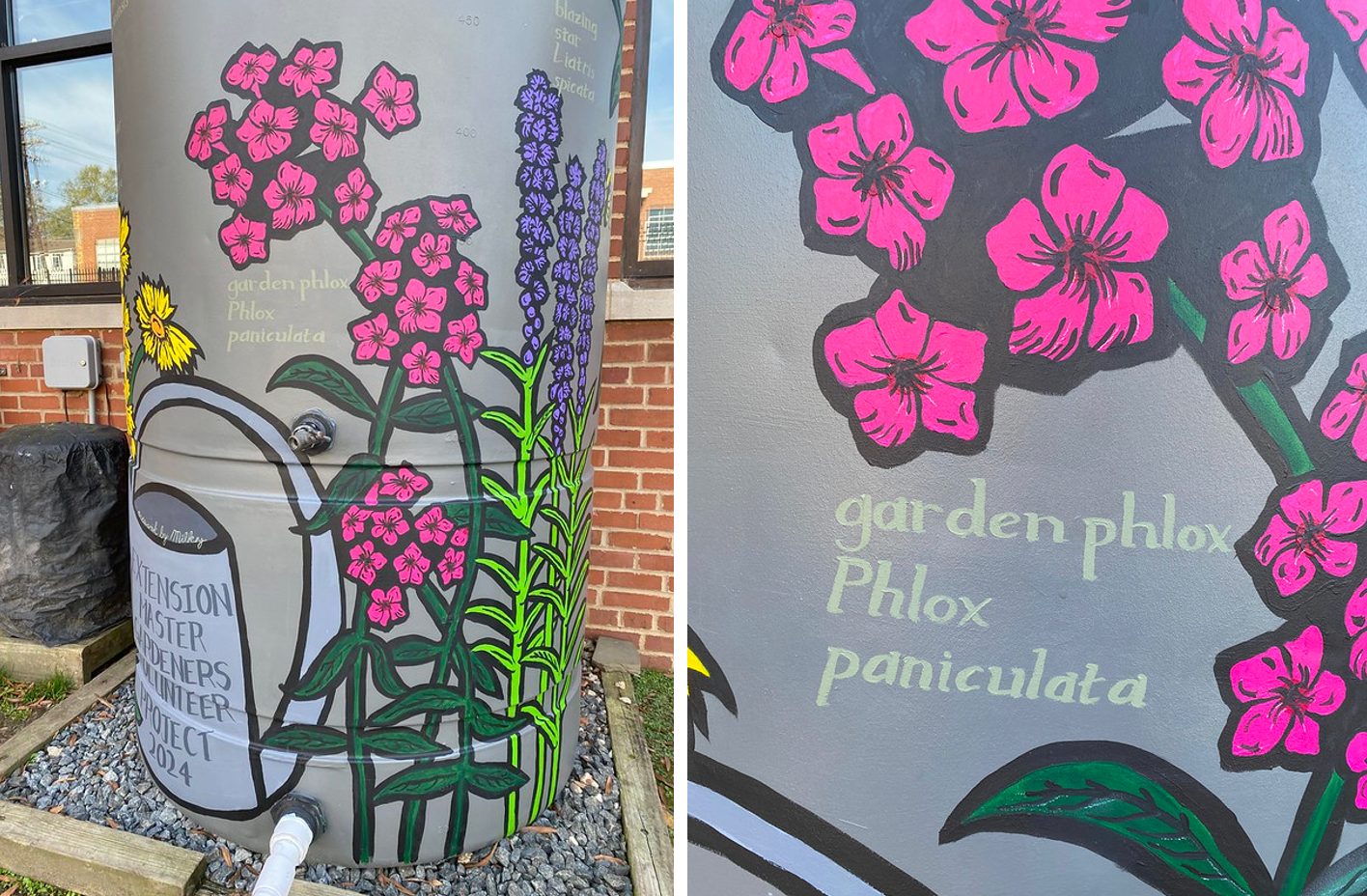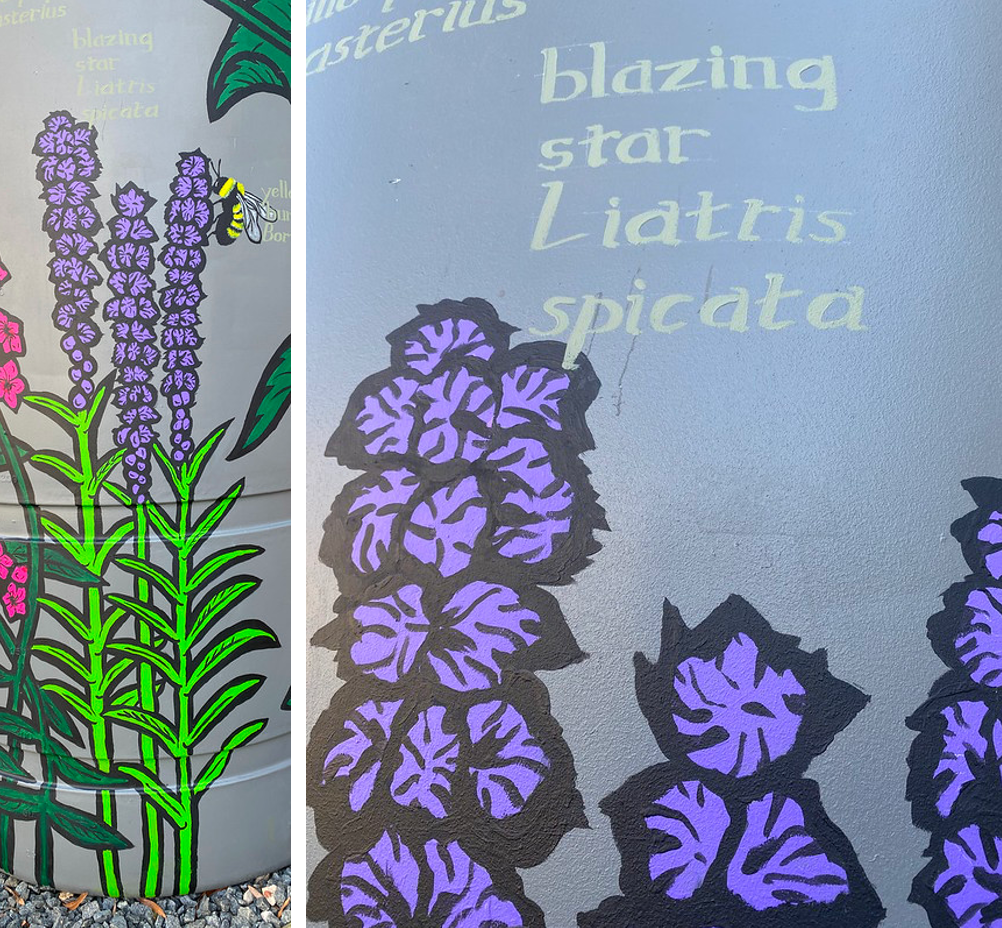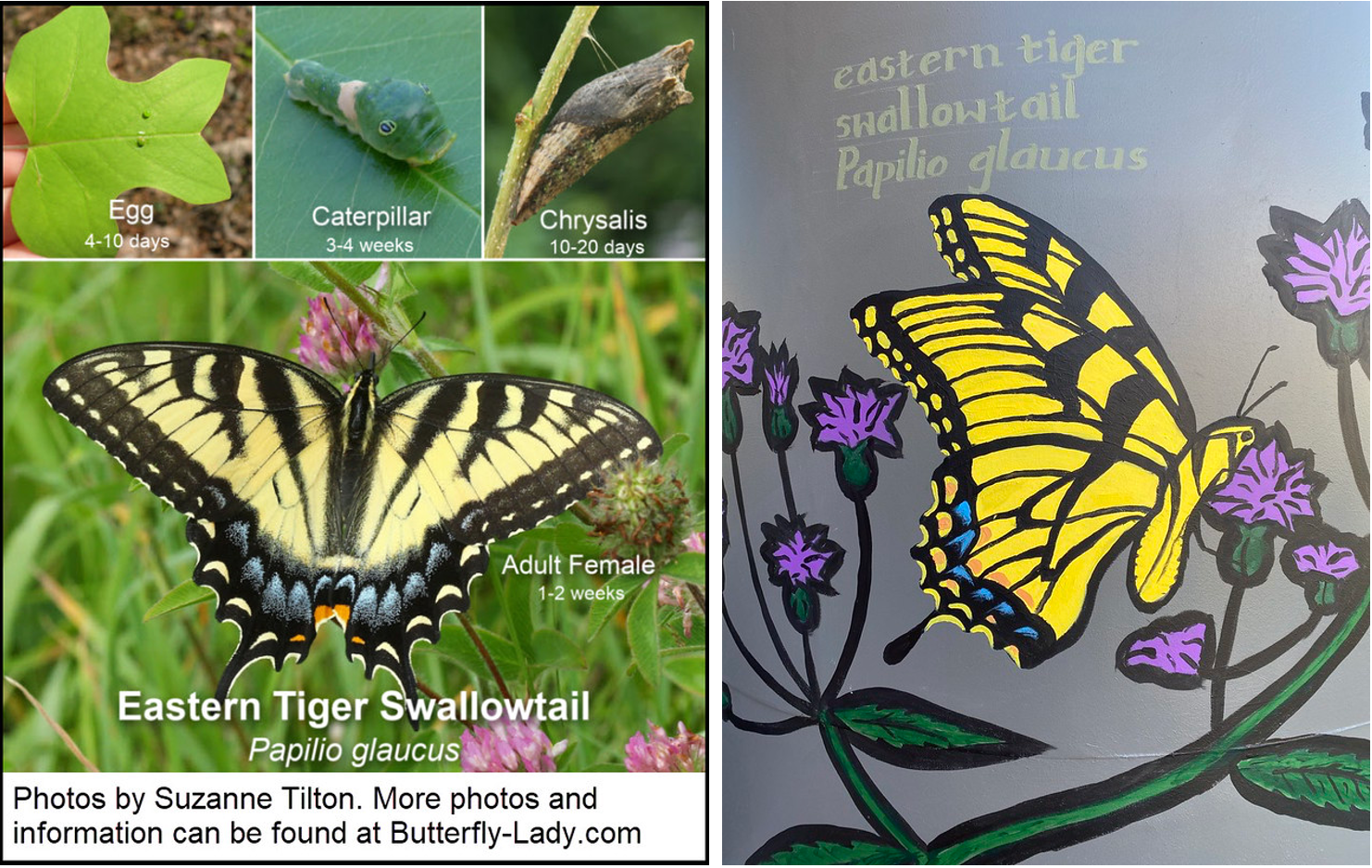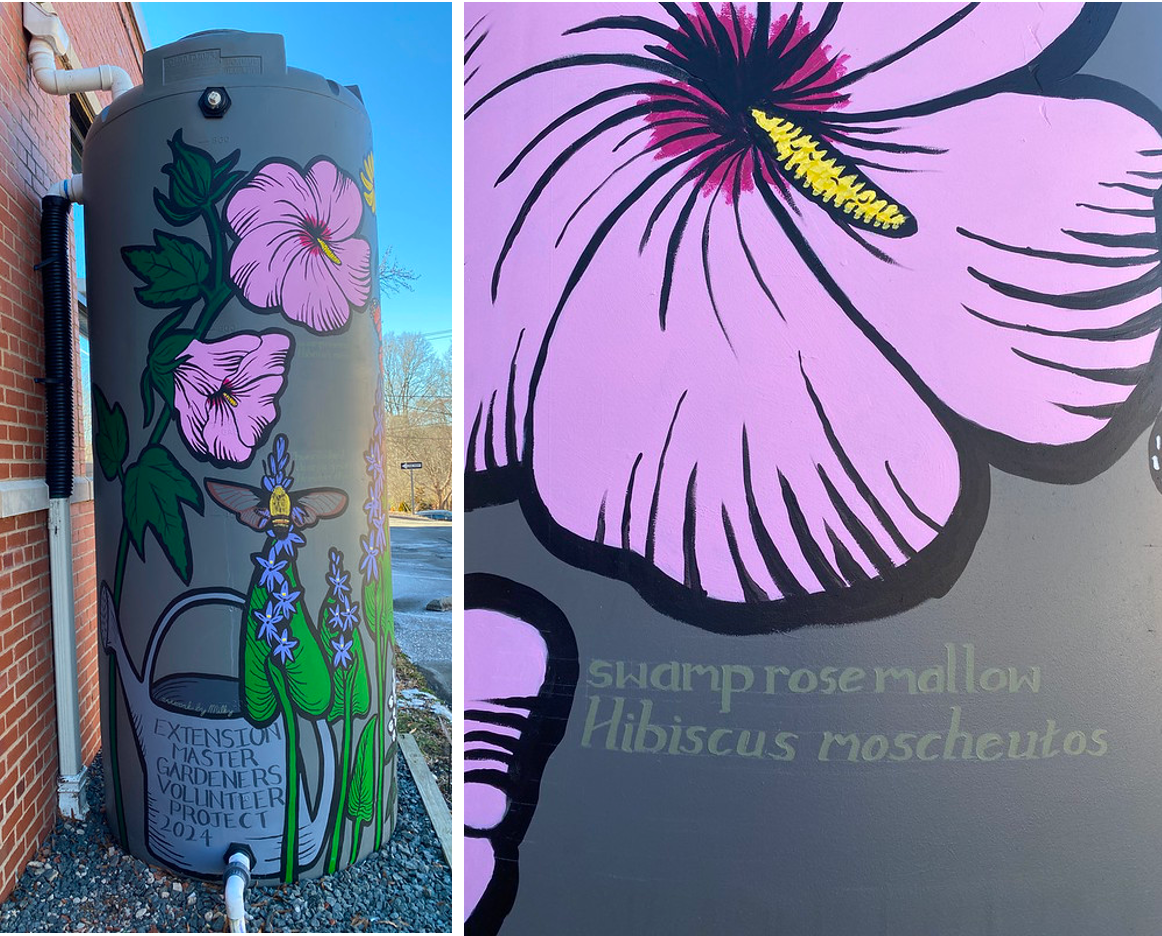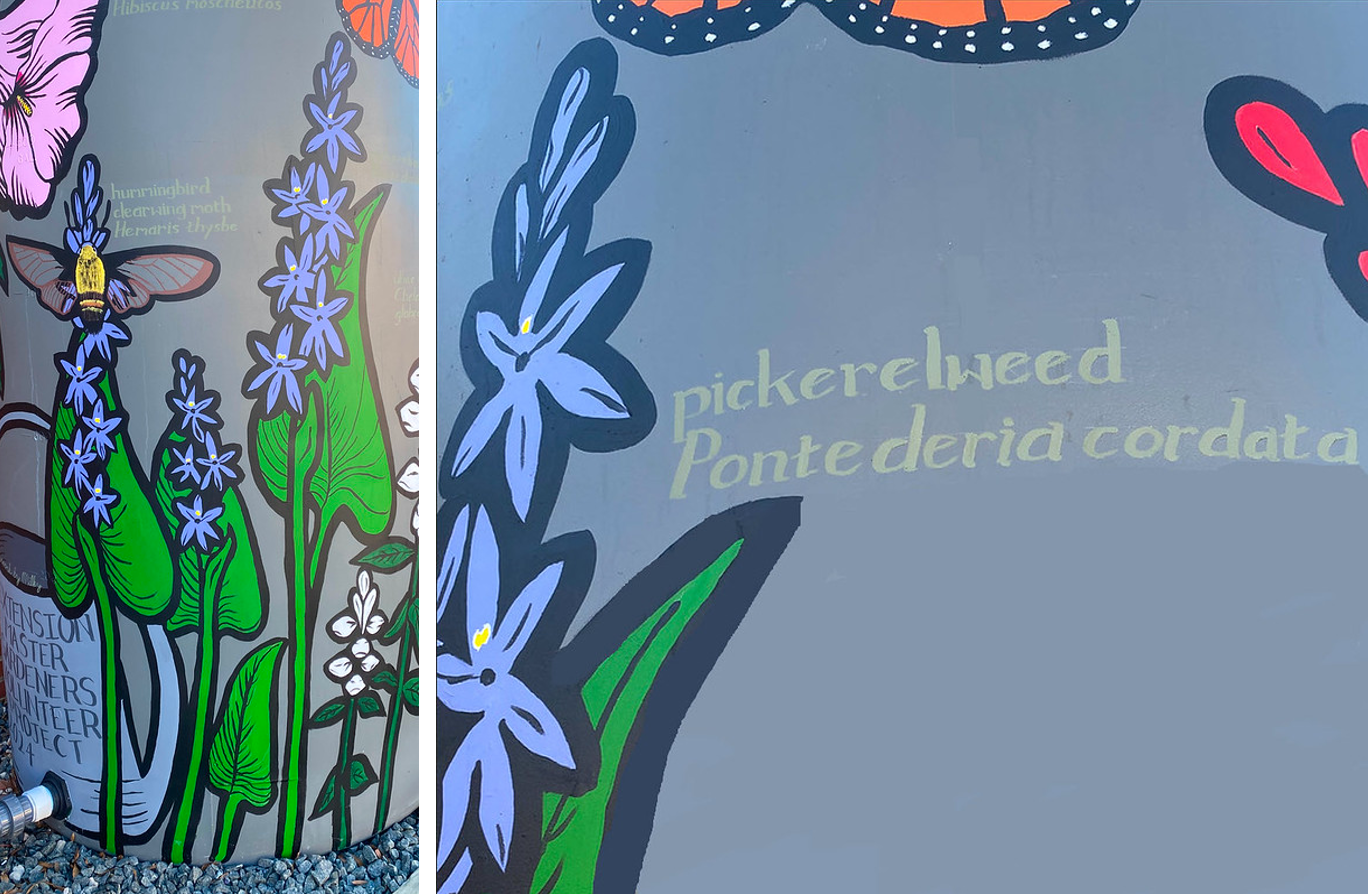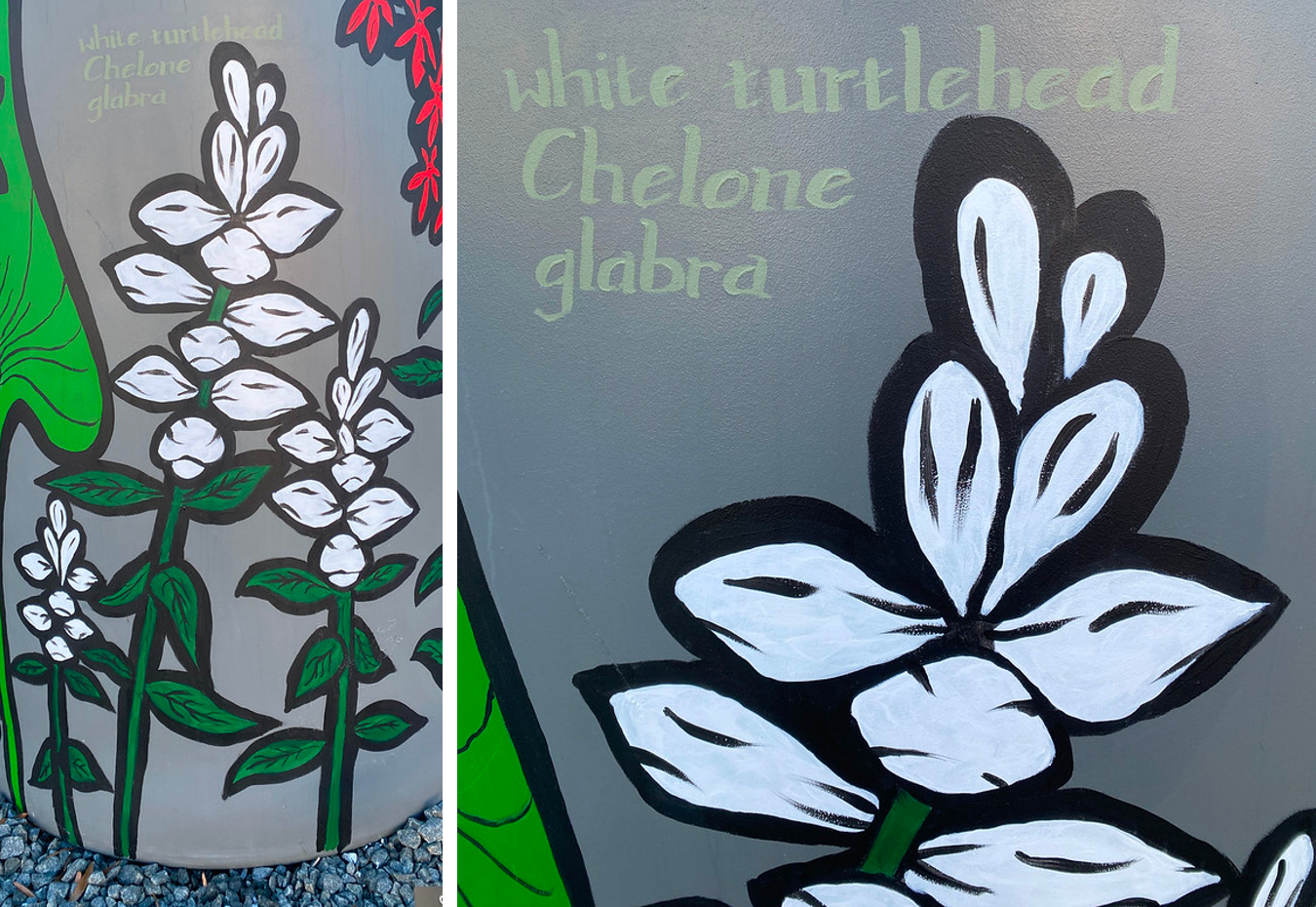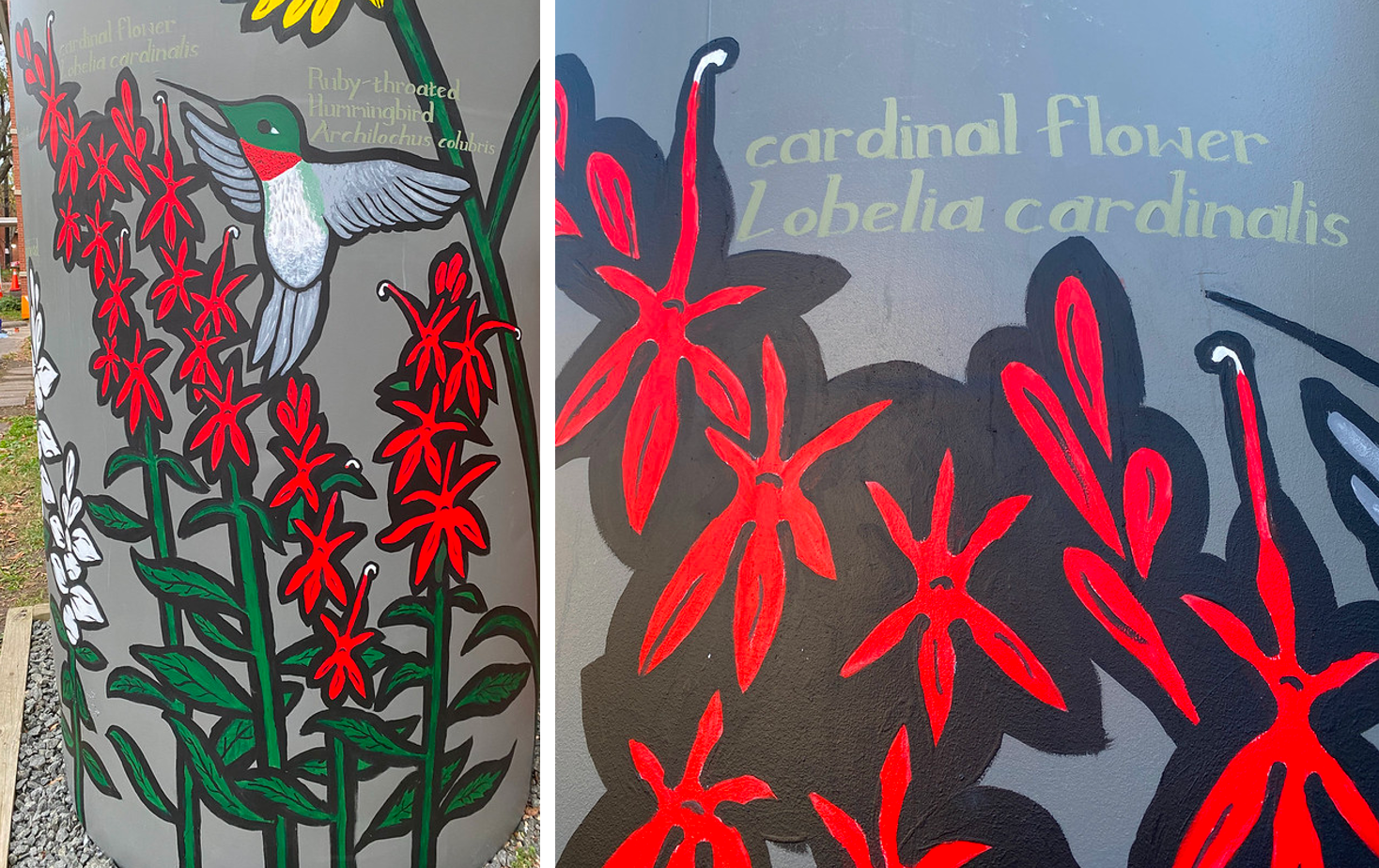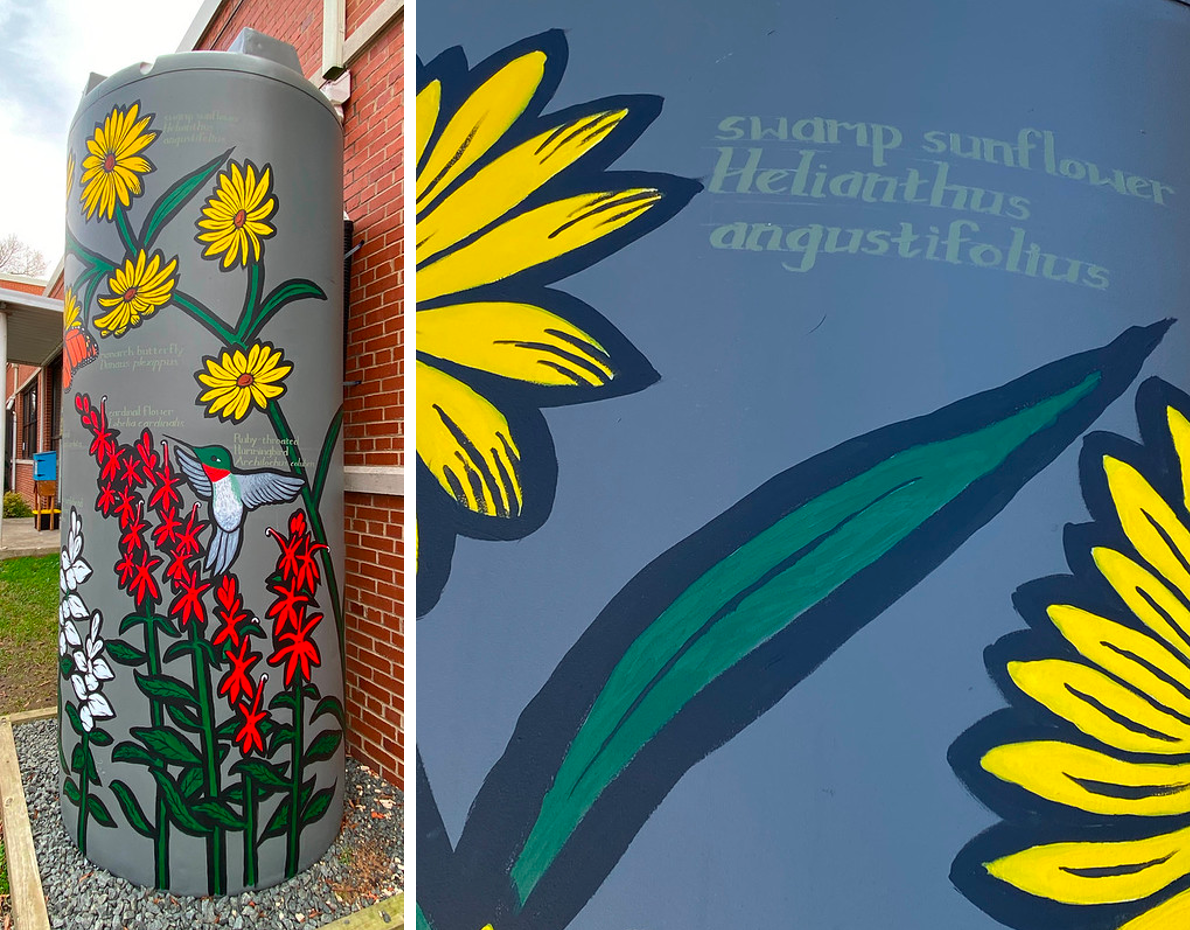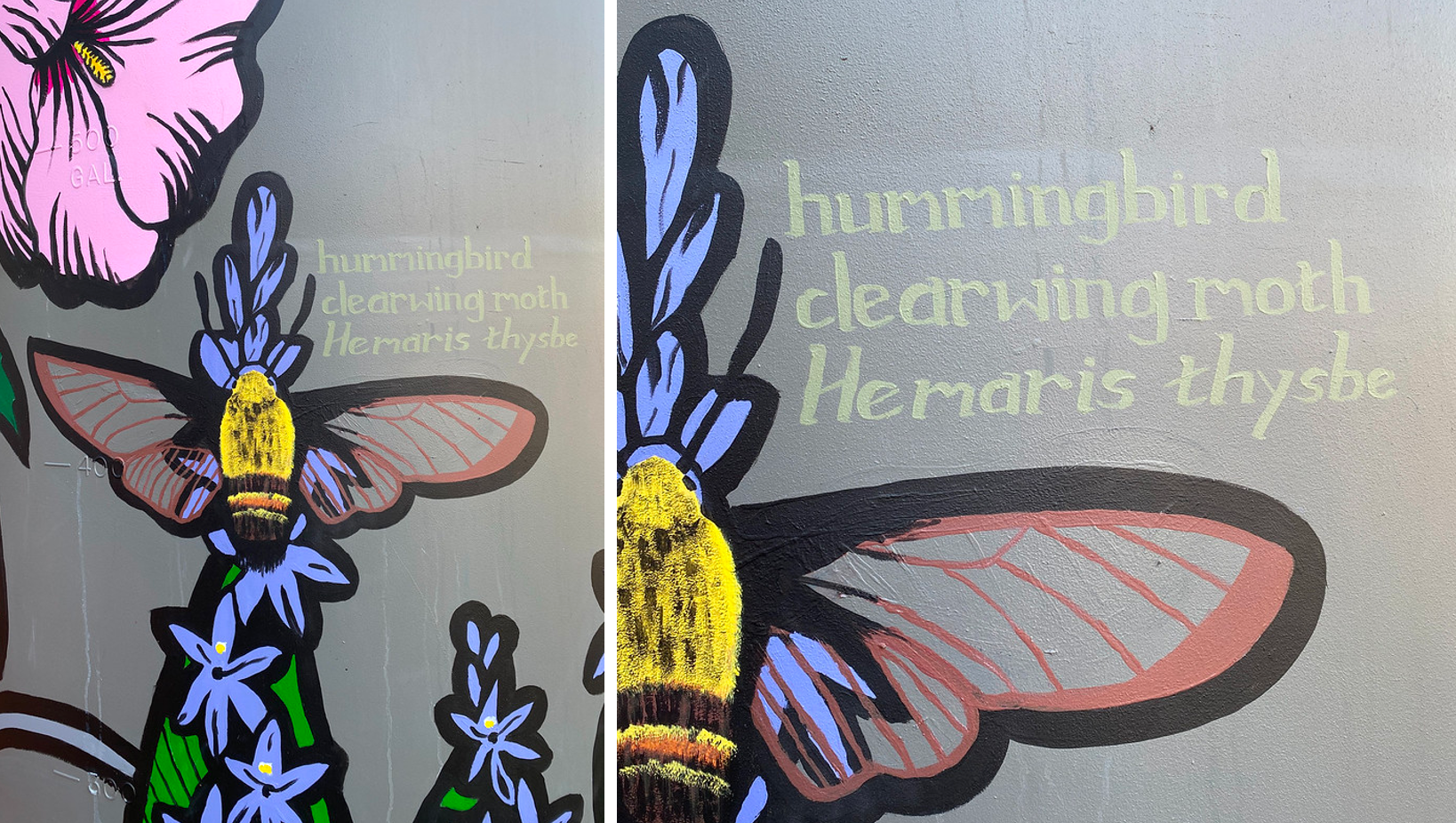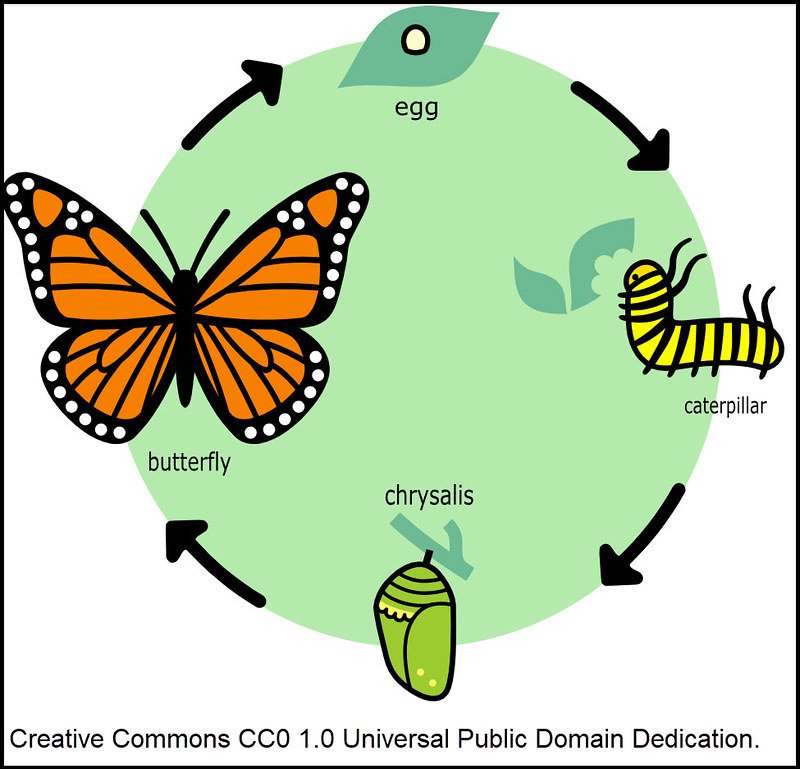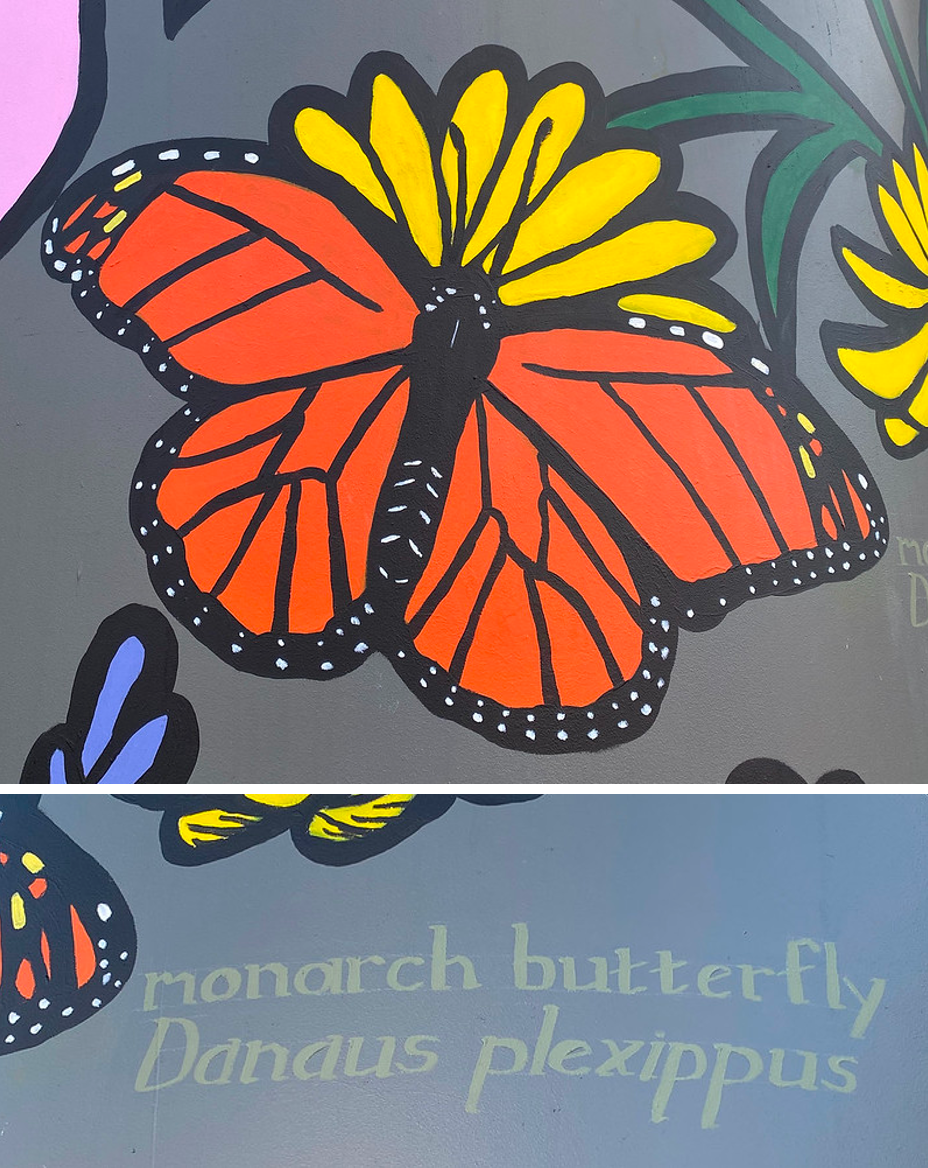Cistern Design Decisions – Plants and Pollinators Featured
go.ncsu.edu/readext?1058863
en Español / em Português
El inglés es el idioma de control de esta página. En la medida en que haya algún conflicto entre la traducción al inglés y la traducción, el inglés prevalece.
Al hacer clic en el enlace de traducción se activa un servicio de traducción gratuito para convertir la página al español. Al igual que con cualquier traducción por Internet, la conversión no es sensible al contexto y puede que no traduzca el texto en su significado original. NC State Extension no garantiza la exactitud del texto traducido. Por favor, tenga en cuenta que algunas aplicaciones y/o servicios pueden no funcionar como se espera cuando se traducen.
Português
Inglês é o idioma de controle desta página. Na medida que haja algum conflito entre o texto original em Inglês e a tradução, o Inglês prevalece.
Ao clicar no link de tradução, um serviço gratuito de tradução será ativado para converter a página para o Português. Como em qualquer tradução pela internet, a conversão não é sensivel ao contexto e pode não ocorrer a tradução para o significado orginal. O serviço de Extensão da Carolina do Norte (NC State Extension) não garante a exatidão do texto traduzido. Por favor, observe que algumas funções ou serviços podem não funcionar como esperado após a tradução.
English
English is the controlling language of this page. To the extent there is any conflict between the English text and the translation, English controls.
Clicking on the translation link activates a free translation service to convert the page to Spanish. As with any Internet translation, the conversion is not context-sensitive and may not translate the text to its original meaning. NC State Extension does not guarantee the accuracy of the translated text. Please note that some applications and/or services may not function as expected when translated.
Collapse ▲Our goals as Master Gardeners include educating people about the importance of native plants and pollinators for the health of our environment and our city. Native plants, those species that evolved naturally in a region without human intervention, developed and adapted to local soil and climate conditions over thousands of years. They are vital parts of local ecosystems necessary for the survival of pollinators, insects, birds, mammals, and other wildlife.
Replacing natives with plants from other regions cannot replicate the complex interactions that naturally occur. For more on the importance of native plants, check out these websites:
This background helped us with several design decisions for the cisterns. First, we chose to highlight native plants from two different habitats. The cistern on the left side while facing the building offers a variety of native plants from a garden or prairie environment while the cistern on the right features native plants that commonly grow in swampy or wetland areas. Garden plants are visible in the Demonstration Garden in front of the building but few people are aware of how close we are to the South Ellerbe Creek wetland and stream restoration project just around the corner at 808 W Trinity Avenue. Check out this link to see the plans for that wetland environment. Working on this wetland area is part of artist Dave Milkereit’s day job!
South Ellerbe Restoration Project
Second, we wanted to draw attention to the importance of pollinators, such as bees, moths, butterflies and birds, for the health of a natural environment.
And finally, we wanted to underscore the importance of the naming and relationships of plants and animals. To correspond with the signage in the Demonstration Garden, we added common and scientific names to all of the plants and animals painted on the cisterns.
Below, a link with each plant painted on the cisterns will take you to The North Carolina Extension Gardener Plant Toolbox, a site managed and maintained by NC State and N.C. A&T State universities, with detailed descriptions and photographs of 4,717 plants that grow in and around North Carolina. The description of each plant is from the introduction on the Toolbox web page for that plant.
Also, below is a brief description of each of the pollinators displayed on the cisterns along with a link to a website with more information and some fun facts about them.
Quick Links for featured plants and pollinators
Table of Contents
Left-hand cistern – prairie or garden flowers and pollinators
- New York ironweed
- large flower tickseed
- garden phlox
- blazing star
- cup-plant
- Eastern tiger swallowtail
- black swallowtail
- yellow bumble bee
Right-hand cistern – wetland flowers and pollinators
- swamp rose mallow
- pickerelweed
- white turtlehead
- cardinal flower
- swamp sunflower
- hummingbird clearwing moth
- monarch butterfly
- Ruby-throated Hummingbird
h2 id=”left cistern”>Left hand cistern – prairie or garden flowers and pollinators
New York ironweed (Vernonia noveboracensis)
Ironweed is an herbaceous native perennial wildflower in the Aster family and is found in all areas of NC. A perennial is a plant that lives more than two years and produces new foliage, flowers, and seeds each growing season. New York Ironweed may grow 5 to 8 feet tall with deep purple flowers that appear in clusters from mid-summer to mid-fall on strong stems. This low maintenance wildflower naturalizes easily and is adaptable to garden conditions.
Ironweed prefers rich moist acidic soils but will grow in average moist to wet soils in full sun. Use this plant in a rain garden, cottage garden, meadow, along streams or ponds or the back of the border. If a shorter plant is desired, prune it back in spring to about 2 feet. It is attractive if blooming occurs at different heights, so prune to different heights for this effect.
This plant was selected as the 2004 NC Wildflower of the Year, a program managed by the North Carolina Botanical Garden with some financial support from the Garden Club of North Carolina.
large flower tickseed (Coreopsis grandiflora)
Large-Flower Tickseed is a native perennial wildflower in the aster family. It has very showy bright yellow flowers and blooms from late spring to late summer. If you deadhead the spent flowers, you can prolong the blooming season. Deadheading is removing individual, spent flowers from a plant for the purpose of preventing senescence and prolonging blooming. For effective results, the ovary behind the flower must be removed as well.
Large flower tickseed is clump-forming and grows 1-3 feet tall and wide. It prefers a sunny location in well-drained soil in the drier portion of the garden. Its preference is for sandy or rocky soils but it can adapt to clay soils if it’s well-drained. Large-Flower Tickseed may not always be reliably perennial but will reseed itself in the garden. Clumps can also be divided in early spring.
Use in the border or rock gardens and in swaths to provide a long season of color.
garden phlox (Phlox paniculata)
Phlox paniculata is an erect herbaceous perennial that may grow 2 to 4 feet tall and is clump-forming. Flowers come in various colors and bloom mid-summer to mid-fall. It mixes well with other perennials, attracts hummingbirds, and is a good selection for a bird garden. This popular flower has escaped gardens and naturalized into areas beyond its original native range.
Phlox paniculata prefers sun to partial shade and moist, fertile, and well-drained soils. Good air circulation (adequate spacing and thinning of stems as needed) will help combat powdery mildew. Overhead watering should be avoided. Water these plants at the base of the stem. Phlox needs to be watered in dry summers and mulched to keep the root zone cool. Removing faded flower panicles will prolong blooming and prevent self-seeding as cultivars do not come true from seed.
In winter, plants should be cut to the ground and removed from the garden in order to minimize possible powdery mildew infection for the following season. This plant has numerous pest and disease problems and is not always an easy plant to grow well. Phlox bugs, powdery mildew, and root rot can be serious problems. Spider mites can also be a problem, particularly in hot, dry conditions. Taller stems may need staking.
For more information about these diseases, check out the North Carolina Extension Gardener Handbook chapter on Plant Diseases and Disorders.
blazing star (Liatris spicata)
Marsh blazing star, in the Asteraceae (daisy or aster) family, is a clump-forming perennial that typically grows 3 to 6 feet tall. It is native to the eastern United States and is most often found in moist areas or growing in meadows. In NC it is found in the coastal and Piedmont areas. The tall spikes of flowers bloom from the top down, are showy and attract pollinators. The foliage is grass-like and grows in clumps.
This low-maintenance plant prefers average to moist, well-drained soils that range from acidic to neutral in pH. It grows well in full sun to partial shade and also tolerates summer heat and humidity. This particular species does better in moist soils than some other blazing stars. The plant has corms with shallow fibrous roots and can produce new colonies from its corms, though it most often propagates by seed. A corm is a below ground stem that is solid, swollen, and covered with reduced, scale-like leaves (for example, in crocus).
It is very attractive in mass plantings in a pollinator garden, rain garden, perennial border, native plant garden, or a cottage garden. It is a host plant for the larvae of both the Liatris flower moth (Schinia sanguinea) and the Liatris borer moth (Carmenta anthracipennis).
cup-plant (Silphium perfoliatum)
Common cup-plant is a native wildflower in the Asteraceae (daisy) family. It typically grows to around 6′, however, can grow to reach 9′ tall.
It is commonly found in open woods, lake borders, ditches, meadows, prairies, and thickets in the Midwest and Upper Midwest. In NC, it is restricted to the Piedmont and Mountains, where it is rare.
The common name Cup-Plant is in reference to the stout leaves that join at the stem, forming a cup that will hold water. Birds, especially goldfinches, are attracted to the water and also eat the seeds. Bumblebees and honeybees use parts of the plant for nesting. Short-tongued bees, wasps and flies frequent the flowers for pollen and nectar.
Although it is clay soil tolerant, the preferred soil for planting is loam-based. Loam is a soil with roughly equal proportions of sand, silt, and clay particles.
When propagating from seed, this plant may not produce flowers until its second season. Once established, the plant will have created deep roots, making it somewhat difficult to remove or transplant. Young offshoots from the main plant can be more easily removed and/or transplanted.
Both tall and large, this plant is good for prairie, native or wildflower gardens, and naturalized areas. Reproducing by the abundance of seed, it will spread throughout the landscape.
Eastern tiger swallowtail (Papilio glaucus)
Papilio glaucus, the eastern tiger swallowtail, is a species of butterfly native to eastern North America. It is a large and commonly seen butterfly. They can be found in deciduous woodlands, forests, wetlands, flower gardens, where there are budding trees and in weedy areas along roadsides. This is the state butterfly of North Carolina.
Their wingspan ranges from around 3” to 5.5” across. Males and females have different appearances, which is known as dimorphism. The male is yellow with 4 black tiger stripes. They may have a hint of blue color at the base of the wings. The female can be seen either in a yellow “morph” or base color or a black morph. They have more blue shading along the hindwings. The females are slightly larger than the males and southern butterflies are larger than their northern counterparts. The butterfly we have drawn on the cistern is a yellow-morph female. Both male and female have long tail extensions that look similar to the tails of birds called swallows which is where they get their name from.
Their life cycle includes 4 different stages: egg→caterpillar (also known as the larval stage)–>chrysalis (the pupal stage)–>adult butterfly. The eggs are laid on the underside of leaves. Tiger swallowtails require native trees. Common egg-laying sites are found among the leaves of black cherry (Prunus serotina) and tulip tree (Liriodendron tulipifera), with white ash (Fraxinus americana), ironwood (Carpinus caroliniana), sweet bay magnolia (Magnolia virginiana), and members of the willow family (Salix sp.). The eggs are yellowish green with red dots. After about a week, the eggs hatch and the caterpillar emerges. The younger caterpillars are brown and white mimicking bird droppings. Older caterpillars are green with two black, yellow and blue eyespots on their thorax. The caterpillar becomes a chrysalis. These can be found on tree trunks, fence posts or in leaf litter. In colder climates, hibernation occurs during this stage. The butterfly emerges from the chrysalis. The lifespan of the adult butterfly is about 2 weeks.
black swallowtail (Papilio polyxenes ssp. asterius)
The black swallowtail butterfly is part of a larger family of butterflies known for their long tails. These look like the tails of birds known as swallows. The eastern subspecies of the black swallowtail is known as a subspecies (ssp.) known as asterius. They are generally 2.5-3.3 inches in size, smaller than the other swallowtail displayed on the cistern, the yellow tiger swallowtail. Females are larger than males. The yellow, white spots along the wings are brighter in males but the blue coloration is much more prominent in females. Both sexes have the red/orange and yellow spot with a black bullseye along their hindwing. The butterfly displayed on the cistern is female.
The life cycle is similar to other butterflies and includes 4 different stages: egg→caterpillar (also known as the larval stage)–>chrysalis (the pupal stage)–>adult butterfly. Eggs are pale yellow. Young caterpillars are mostly black and white with a saddle, and older caterpillars are green with black transverse bands containing yellow spots. The egg stage lasts 4–9 days, the larval stage 10–30 days, and the pupal stage 18 days. The duration of these stages may vary depending on temperature and the species of the host plants. In colder environments, hibernation occurs in the chrysalis stage.
The caterpillars absorb toxins from leaves and taste poorly to bird predators. Like other caterpillars, the black swallowtails have a gland known as an osmetrium. It is located near the front of the caterpillar, in the prothoracic segment, and looks like an orange snake tongue. When the larvae (caterpillar) is disturbed, it everts (sticks out) the osmetrium and emits a foul smell.
Like other butterflies, the black swallowtail must carefully regulate their temperature. They do this by changing their abdominal position, wing position, orientation to the sun, perching height and perching duration.
Yellow Bumble bee (Bombus fervidus)
Bombus fervidus is a small bumble bee with worker bees generally about 0.3-0.5 inches long and queens and larger drones around 0.75-1 inch long. The word Bombus is Latin for “buzzing”! Among the bumble bees, it is long tongued and specializes in flowers with longer corollas (petals).
This is primarily a northern bumble bee but its range does extend down to North Carolina. This bee prefers grassy open areas and can be found along roadsides and in grazing farmlands. The nests are typically at ground level but can also be below ground. They are typically within 150 feet of their primary food source which will contain enough pollen and nectar to feed the entire nest. They collect from a large variety of flowering plants but are often found on clover. Bumble bees do not produce nearly as much honey as honey bees and live in much smaller colonies.
Unlike honey bees, bumble bees do not communicate by dancing. But if a good source of nectar is found the worker bee will do an “excited run” through the nest fanning its wings and releasing pheromones.
The queen will live up to a year, hibernating in colder months. Other bees in the nest do not survive the winter. The queen mates once in her lifetime and stores the sperm. She builds the nest herself in the spring and lays individual eggs in cells she creates within the nest. The function of male bees is primarily reproductive. The workers are infertile females. The average lifespan of a worker bee is about 34 days.
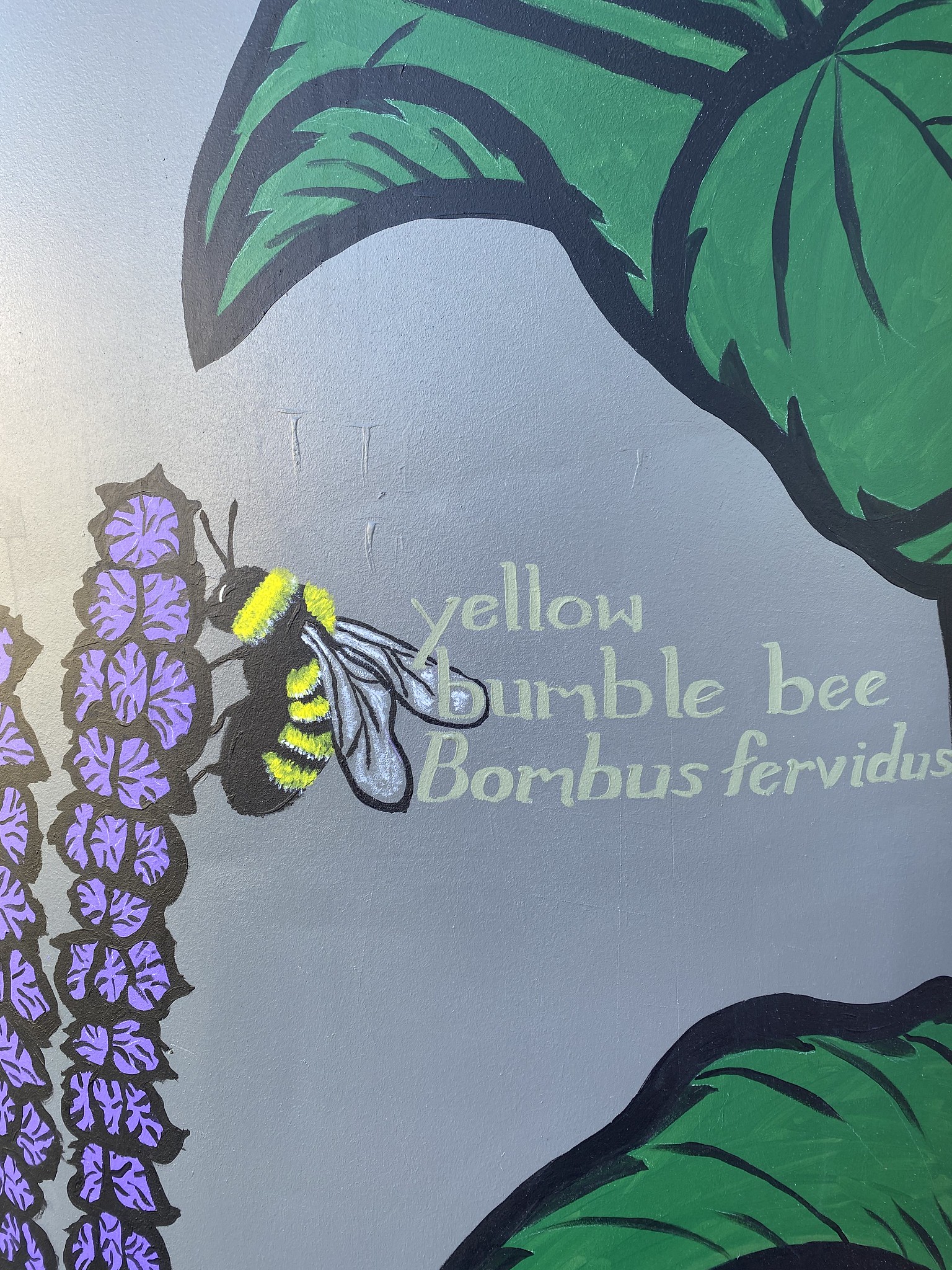
h2 id=”right cistern”>>Right hand cistern – wetland flowers and pollinators
Swamp Rose Mallow (Hibiscus moscheutos)
Rose Mallow is a tall, shrub-like, perennial in the Malvaceae or mallow family. It has huge hollyhock-like flowers in shades of white, pink, red, or burgundy that bloom from midsummer to early fall. The flowers measure up to 8 inches in diameter and have spreading petals with a contrasting central eye of red or burgundy and protruding staminal column that is creamy white to pale yellow. The plant grows upright from to 2 to 6 feet tall and 2 to 5 feet wide and has multiple sturdy stems. The flowers are replaced by seed capsules that are 1 to 1.25 inches long, oval, and short-beaked. The seed capsule contains a ring of seeds.
Rose Mallow is native to wetlands and creek edges in the southeastern United States and is found in all areas of North Carolina.
The genus name, Hibiscus, is an old Greek and Latin name for mallow. The specific epithet, moscheutos, is Latin for mush-scented.
This plant prefers full to partial sun and wet to constantly moist soils containing loam, silt, or some sand with organic material and a slightly acidic pH. In full sun, the plant has better bloom production and is more disease resistant. This plant is heat, humidity, and wet soil tolerant, and it is slightly salt tolerant. Plant in a protected area to prevent wind damage, and be sure to provide good air circulation. Pinching back the growing tips will encourage the plant to be more bush-like, and deadheading the spent flowers will improve the plant’s appearance. The individual flowers are short-lived, but the blooming period generally lasts about 1 month. Cut back the stems nearly to ground level in the fall. Flowers will appear on new growth. Propagation is through seed planting, stem cuttings, or plant division.
Use Rose Mallow in the lowest area of the garden, as a specimen, along streams or ponds, or as a temporary summer screen or hedge. Plant in native, pollinator, butterfly, or rain gardens. It can also be grown in large containers. Its saucer-shaped flowers are a wildlife food source and are an attractant for pollinators, hummingbirds, butterflies, and specialized bees.
Pickerelweed (Pontederia cordata)
Pickerelweed is a native herbaceous emergent in the Pontederiaceae family. “Emergent” plants are rooted in the bottom of a lake or pond and typically grow along their shorelines in water that’s 4 feet to 5 feet deep. Herbaceous plants are soft, pliable, and usually barkless. They do not have stiff, woody growth. Pickerelweed stems and leaves extend out above the water, unlike submerged plants that reside entirely underwater. Plants like these provide filtering for toxins found in runoff. Pickerelweed is found growing along shallow shorelines up to 4 feet tall and is found in all areas of NC.
The thick rhizomes spread to form large colonies. Its preference is for freshwater depth up to 12 inches in full sun in rich loamy soils. It can tolerate part sun, poor soils, and occasional flooding up to 20 inches. The tall spikes of lavender-blue flowers last from summer through fall and attract many pollinators. They are held well above the water for a showy long season display. This plant is “resistant” to browsing by deer and is tolerant of heat. Note that no plant is completely deer resistant if they are hungry.
Use this plant along bogs, ponds, or streams. It can also be grown in a large container or water gardens. It is very important to maintain water depths greater than saturation, but shallower than the leaves year-round.
White Turtlehead (Chelone glabra)
White Turtlehead is a native, clump-forming wildflower found in moist areas along stream banks, open woodlands, fens, flood plains and marshes. The blooms appear on 6-8 inch spikes and open from bottom to top in late summer to fall. Its common name comes from the appearance of the flowers which look like the heads of tortoises. In Greek, Chelone means tortoise. Phonetically, this is pronounced kay-LOH-nee GLAY-bruh.
Chelone glabra is a popular browse plant for deer so for the home gardener it needs to be grown in an area that is protected. They do well around ponds and grow best in less than full sun, generally around 4 hours of sun daily. The flowers are attractive to bumblebees and other pollinators and are a host plant for beautiful Baltimore checkerspot and buckeye butterflies.
Cardinal Flower (Lobelia cardinalis)
Cardinal flower is an herbaceous perennial in the Campanulaceae (bellflower) family that may grow 4 to 5 feet tall. The common name is in reference to the red robes worn by Roman Catholic cardinals.
It is easily grown in rich, medium to wet soil in full sun to part shade. The soil should never be allowed to dry out, and It will tolerate brief flooding. Although it will tolerate full sun in northern climates, it appreciates partial afternoon shade in hot summer climates of the lower Midwest and South. Root mulch should be applied in cold winter climates to protect the root system and to prevent root heaving. Mulch will also help retain soil moisture. If desired, this plant can be grown in a 1 gallon or larger container using rich, moist potting soil.
The shiny leaves are alternate with a toothed margin and their rhizomes overwinter with small rosettes of leaves. Brilliant red blooms first mature in late summer and continue into mid-fall. The showy flowers begin opening at the bottom of a terminal flower spike and continue to the top. Propagate this plant either by seed or by separating the rosettes from the parent plant in the spring.
A number of hybrid cultivars of the Cardinal flower have been produced; the most popular is ‘Queen Victoria’ with blood-red flowers and bronze foliage.
This plant is effective in moist areas of woodland/shade gardens, wet meadows, or along streams or ponds. Also water gardens and rain gardens. It also adds late summer bloom and height to borders as long as the soil is kept uniformly moist. It attracts hummingbirds and butterflies making it a welcome addition to a pollinator garden.
swamp sunflower (Helianthus angustifolius)
Swamp sunflower is a native perennial member of the aster family and can be found from NY to FL to TX. It is a large perennial that can grow up to 8 feet tall with showy yellow daisy-like flowers from mid to late summer into fall. Prune plants back in June to encourage branching. It prefers moist to occasionally wet acidic sandy to clay loams in full sun. It can be grown on drier soils if adequate moisture is provided. It will tolerate part shade but flowers better in full sun. This plant is a favorite of pollinators and songbirds. There are shorter cultivars available if desired.
Use this plant in the back border of a native/pollinator garden, naturalized area, or along streams and ponds. Give it room to grow and spread and you will have a profusion of late-season flowers when little else is blooming.
This plant was selected as the 2007 NC Wildflower of the Year, a program managed by the North Carolina Botanical Garden with some financial support from the Garden Club of North Carolina.
hummingbird clearwing moth (Hemaris thysbe)
The hummingbird clearwing moth is a large moth in the family Sphingidae (hawkmoths). They show a large variety of coloration but typically the moth is olive green and burgundy on its back, and white or yellow and burgundy on the underside. Because of the variability in color, it has taken quite some time for scientists to decide that this is all one species. The body is covered by thick fur. When it first hatches, the wings of H. thysbe are dark red to black. As it begins to fly, scales fall off leaving a mostly clear wing with reddish-brown borders and veins.
The moth’s wingspan is 1.6-2.2 inches. Because of its size and the way it beats its wings when it hovers, it is often confused with hummingbirds or bumble bees. It has a long tongue and is a flower pollinator. It is a migratory species and has a typical moth life cycle with two broods per year in the southern US but only one brood per year further north. This moth prefers pink and yellow flowers and hovers as it collects nectar, moving rapidly from flower to flower.
Monarch Butterfly (Danaus plexippus)
The name “monarch” is believed to have been given in honor of King William III of England, as the butterfly’s main color is that of the king’s secondary title, Prince of Orange. Monarchs are a popular and well known butterfly but their numbers have been estimated to have declined by about 80% since 1980. Much of this has been due to decreased abundance of milkweed related to climate change, herbicide use, genetically modified crops and diseases. Adults can feed on many different plants but monarch larvae (caterpillars) are dependent on milkweed (Asclepias species).
Like all butterflies in this family, monarchs undergo complete metamorphosis. Their life cycle has four phases: egg, larva, pupa, and adult. During their development, both larvae and their milkweed hosts are vulnerable to weather extremes, predators, parasites, and diseases; commonly fewer than 10% of monarch eggs and caterpillars survive. Adults typically live for 2–5 weeks during their breeding season.
Monarchs are well known for their yearly long distance migration to extreme southern states and Mexico where they over winter. An individual monarch does make this entire journey, It takes many generations of monarchs to make this journey each year.
Monarchs are orange in color to warn predators that they have an undesirable taste and are poisonous. Milkweed plants contain the toxins which the larvae acquire while eating the leaves. Some predators have developed insensitivity to these toxins or have developed ways to safely eat only certain parts of monarchs that contain lower concentrations of the toxins.
Ruby-throated Hummingbird (Archilochus colubris)
The Ruby-throated hummingbird is the only breeding hummingbird found in North Carolina. Occasionally other species may spend the winter here but chances are if you see a hummingbird, it’s a Ruby-throat. They spend summers in North Carolina but migrate to central America for the winter. Adult female Ruby-throated Hummingbirds have an average weight of only 3.5 grams, adult males just 3.0 grams, which is the weight of 3 potato chips or 2 blueberries! Hummingbirds don’t sing. They have a rapid squeaky chipping usually used during aggression. They also use the humming of their wings to communicate.
Ruby-throats put on amazing aerial displays and aggressively defend flowers and other food sources. Their flying ability is unmatched in the bird world. They eat nectar from flowers but also eat many insects.
Below are some very cool facts about the hummingbird from the Cornell Lab of Ornithology.
- The nest takes 6-10 days to finish and measures about 2 inches across and 1 inch deep with the inner cup about the size of a large thimble. The nest is built directly on top of the branch rather than in a fork. It’s made of thistle or dandelion down, held together with strands of spider silk and sometimes pine resin. The female stamps on the base of the nest to stiffen it, but the walls remain pliable, allowing it to stretch as the chicks grow. She shapes the rim of the nest by pressing and smoothing it between her neck and chest. The exterior of the nest is decorated (probably camouflaged) with bits of lichen and moss.
- The Ruby-throated Hummingbird beats its wings about 53 times a second.
- The extremely short legs of the Ruby-throated Hummingbird prevent it from walking or hopping. The best it can do is shuffle along a perch. Nevertheless, it scratches its head and neck by raising its foot up and over its wing.
- Ruby-throated Hummingbirds prefer to feed on red or orange flowers (though it’s not necessary to color the sugar water you put in a hummingbird feeder). Like many birds, hummingbirds have good color vision and can see into the ultraviolet spectrum, which humans can’t see.
- Ruby-throated Hummingbirds normally place their nest on a branch of a deciduous or coniferous tree; however, these birds are accustomed to human habitation and have been known to nest on loops of chain, wire, and extension cords.
- Male Ruby-throated Hummingbirds don’t stick around long. Pairs are together long enough for courtship and mating – just a matter of days to weeks. Then he’s off on his own and may begin migration by early August.
- The oldest known Ruby-throated Hummingbird was a female, and at least 9 years, 2 months old when she was recaptured and rereleased in 2014 during banding operations in West Virginia.





